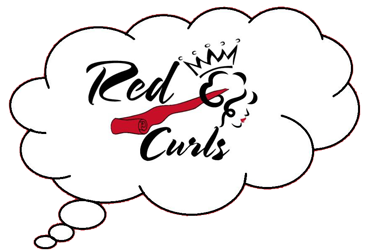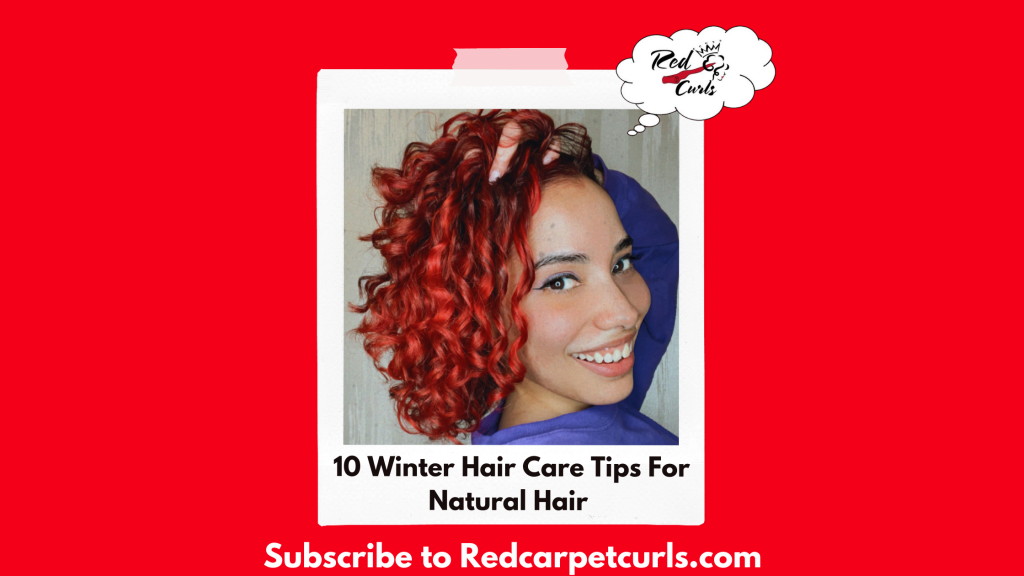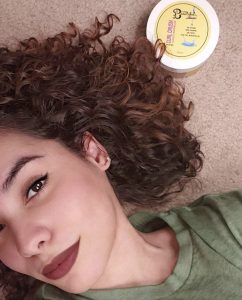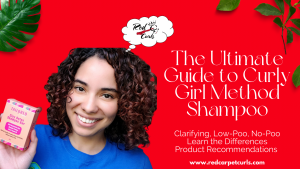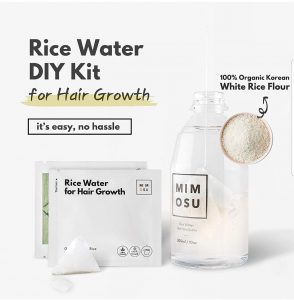The Fall/Winter season change is upon us and by now many of us have fallen into the rut of dry and brittle hair. Since there is less moisture in the air, there’s a prime opportunity for those harsh winds to steal your moisture and glory. This is the worst thing that can happen to naturally textured hair which is already at a moisture disadvantage due to its texture. If you allow the winter to steal the last bit of moisture your hair is grasping onto, all your hard work from the rest of the year goes out the window. No one wants to sacrifice their length or overall hair health, and you don’t have to!
Check out these ten tips to keep your naturally textured hair moisturized, healthy, and thriving this winter.
1) Utilize Steam

Healthy hair starts with a healthy scalp. If your scalp is dry then your hair strands will be dry as well. Steam is an amazing tool to keep handy all year round but definitely during the winter months.
Naturally textured hair is always at a disadvantage when it comes to moisture and that is due to the structure of the strand. Your scalp creates something called Sebum(natural oil) to be the ideal conditioner to moisturize your scalp and hair strands. The oil is meant to travel down your hair shaft all the way to the ends to moisturize and protect it, and that’s normally what happens…for people with straight hair. Naturally textured hair contains, you guessed it, textures. So, it takes a longer period of time for the oil to make its way down all the spirals. This leaves the mid-lengths and ends of your hair dry and vulnerable to split ends/breakage.
Steam prevents this by directing water in the form of moist vapor to hydrate the hair and scalp. The warm vapor from the steam gently lifts the hair follicles, supplying them with more water (moisture). The vapor helps detoxify the scalp by cutting through the build-up. Cutting through build-up keeps the scalp healthy and clean allowing for maximum penetration of moisture.
Steam is also amazing for hair growth. The warm vapor from the steam actually encourages more circulation of blood and oxygen to the hair follicles, which encourages new hair growth.

I love using my Q-Redew hair steamer to hydrate my hair and extend my wash and goes since water is the moisture I need to re-activate my products from the day before. Steam is an amazing way to detangle hair as well without having to fully saturate your hair. The steam vapor gently lifts the scales on the cuticle (outermost layer of the hair strand), which in turn releases any tangles for the hair.
Steam improves the elasticity (stretching ability) of your hair strands by keeping them moisturized and resistant to breakage.
If you cut through build-up (detoxifying the scalp) and keep hair moisturized with water from the steam vapor you will encounter a lot less product build-up because your products will be able to penetrate much quicker and better, giving you better results while using less product.
If you aren’t ready to commit to purchasing the hair steamer (btw Q-Redew accepts Afterpay so you can purchase one for just 4 payments of $19.75).

You can also just use steam from your shower, or use a plastic shower cap(or everyday shopping bag) to insulate the natural heat your scalp produces), or even microwave a towel for a few seconds and put it on top of your plastic cap.
2) Use Moisture Based Cleansing Options

Moisture starts at the beginning of your washday. Your cleansing choice is the perfect opportunity to add more moisture to your washday.
Shampoo is a word that is often feared or misunderstood when it comes to the interwebs so let’s clear up some of that misinformation now, to help you make the best choice for your hair.

There are different categories of shampoo, as discussed in my Shampoo blog post. Let’s start with the big boy on the block known as clarifying shampoo.
Clarifying shampoos are the strongest type of shampoo, that’s why I call them the big boy on the block. Clarifying shampoos are formulated with the strongest surfactant (detergent) group known as Anionic Surfactants. This class (look at me getting fancy and technical with it) of surfactant contains two groups within it, sulfate and sulfate-free groups. Since naturally textured hair is already dry, you do not need damaging sulfates to remove the last bit of moisture you have. Sulfate meeting dry hair will always equal split-ends and breakage.
Instead of using sulfates, naturally textured hair should use sulfate-free anionic surfactants like Sodium C14-C16 Olefin Sulfonate. It looks like a sulfate but it is not. It is the strongest sulfate-free clarifying surfactant you can use, meaning it will remove all types of build-up including silicone, hard-water, and product build-up.
Clarifying the hair at least once a month is vital to keeping the build-up away and keeping your hair clean enough to allow your products to penetrate deep into the strand instead of sitting on top.
My favorite and exclusive clarifying shampoo is the Inahsi Naturals Soothing Mint Sulfate-Free Clarifying Shampoo (save $ by using discount code: redcarpetcurls).

It contains Sodium C14-C16 Olefin Sulfonate, so, it will remove all build-up safely. But I also love that it contains moisturizing ingredients like water, glycerin, and aloe vera. It also contains hydrolyzed oats, which is super important because hydrolyzed protein is small enough to penetrate past the cuticle layer, all the way to the deepest layer of the hair strand known as the Cortex. Hydrolyzed proteins help moisture bind better to hair. So, if you’re looking for a clarifying shampoo look no further! I even use it to remove chlorine from pools during the summer.
Too much of a good thing becomes a bad thing over time. There is such a thing as over-clarifying and this too can lead to split ends and breakage. Remember this is the big boy on the block, and he doesn’t have to make an appearance too regularly. Starting with once a month is fine, and if you have fine or wavy hair you can bump it up to twice a month to help deal with product build-up.
Since the winter winds steal moisture from the hair, between clarifying washes you should be using more moisture-based gentle cleansing options such as low-poo, no-poo, and co-wash.
Low-poos are gentle cleansing weekly shampoos designed to deliver more moisture to the hair than it does focusing on deep cleansing. These types of shampoos cleanse without stripping hair of its natural oil.
Low poos is simply a nickname given to gentler cleansing shampoos to state the fact that the shampoo suds up upon application, not all shampoos will foam up.
One of my favorite low-poos is the Inahsi Naturals Soothing Mint Gentle Cleansing Shampoo (can you tell I am OBSESSED with Inahsi Naturals products? Btw the discount code works for ALL Inahsi Naturals Products!).

The low poo contains gentle surfactants such as Cocamidopropyl Betaine and Sodium Cocoyl Isethionate to cleanse the hair. I also love that it contains moisturizing ingredients like water, glycerin, aloe vera, and Guar Hydroxypropyltrimonium Chloride to moisturize my hair.
I also love using the Tailored Beauty Coconut Creme Shampoo!

Besides smelling like absolute heaven, this low-poo contains gentle cleansing detergents such as; Sodium Lauroyl Methyl Isethionate, Cocamidopropyl Betaine, and Sodium Cocoyl Isethionate. To make it super moisturizing, this product contains ingredients like water, aloe vera juice, glycerin, and Guar Hydroxypropyl chloride. It’s also infused with coconut oil which cleanses and strengthens hair without leaving it feeling stripped.
Next, we move on to No-Poo. These are gentle cleansing shampoos formulated to have the consistency of a conditioner for maximum moisture. Meaning it’s a super moisturizing shampoo that will not foam up.
One of my favorite no-poos to use is the Veracious Curls Cleanser (save $ by using discount code: redcarpetcurls).

This oil-free, conditioning cleanser is designed specifically for curly hair to moisturize, cleanse, and melt away knots and tangles. This creamy cleanser promotes hair strength and growth by maintaining a healthy PH level, preventing dryness, and unclogging hair follicles. This product alone will revitalize your scalp with organic fruit extracts while leaving hair soft and manageable. Speaking from experience, this amazingly moisturizing shampoo feels like you’re co-washing your hair. Paired with a scalp brush, it leaves the hair feeling clean but most importantly moisturized!
Last but not least we cannot forget Co-wash. A co-wash is not exactly a shampoo, although it does lightly cleanse hair. Co-washes are conditioners formulated with gentler surfactants (often Cationic surfactants) to lightly cleanse the hair but most importantly provide more moisture to dry hair. Co-washes are perfect to use in-between clarifying washes.
3) Deep Condition Regularly

Deep conditioning is one of the most important if not the most important steps in your hair care journey. Consider your deep conditioning sessions to be a non-negotiable covenant you make with your hair when you begin your natural hair journey.
Why are your deep conditioning sessions so important?
Deep conditioners are formulated to be the most intensive conditioning treatment. They are formulated with (smaller) moisturizing ingredients. These conditioners are meant to be left on between 20-30 mins per session, no more (especially not overnight)! That is because the ingredients are meant to penetrate past the Cuticle (outermost layer of the hair strand), all the way to the Cortex(innermost layer of the hand strand). The cortex is responsible for over 90% of the overall hair strand’s strength. Your deep conditioner focuses on moisturizing and strengthening this very important layer of the hair.
That is why deep conditioners are responsible for improving the overall health of your hair. If you moisturize and strengthen the hair strand at its deepest layers, you will improve the health and elasticity of your hair protecting it from split ends and breakage.
Deep conditioners should be used once a week, but during the winter months, you may find that your hair is still thirsty, bump your sessions up to twice a week and see how your hair responds. If you have fine or wavy hair and see deep conditioning this often is too much for your hair, bump it down to once every two weeks. This is why I say deep condition regularly, as opposed to putting a definitive schedule to it. Everyone’s hair is different and has different needs. You just need to learn to decipher the language of your own hair.
For those with low porosity hair, make sure your hair is clarified of build-up since this is a common issue due to the scales on your cuticle layer. If your hair is clean of build-up the deep conditioner can penetrate the hair strands more deeply. Also, since low porosity hair has an issue with the scales not lifting to allow moisture in (resulting in dry hair), you need to assist the scales in their lifting process by adding indirect heat like the Q-Redew Hair Steamer or a Microwavable cap like those available from Thermal Haircare Hot Head, and Thermalvibes. Indirect heat helps lift the scales on the cuticle allowing moisture to penetrate more quickly and effectively.
Looking for deep conditioner recommendations? Click here to check out my Deep Conditioning blog post.
4) Utilize Pure Aloe Vera Gel

Aloe vera has universally been regarded as a miracle plant for not only the hair and scalp but, your body as well.
According to a 2009 article in the International Journal of Natural Therapy, “Aloe vera is one of the only known natural vegetarian sources of Vitamin B12, and Aloe vera has been used since ancient times for healing infection and burns. However, with the improvement in cosmetology, it has been proven that Aloe vera is a very important component of cosmetics. It contains almost 20 amino acids, minerals like calcium, magnesium, and sodium in sufficient quantities, enzymes, vitamins, polysaccharides, nitrogen, and other components that make it a miracle beauty herb.”
According to a 2010 article in the International Journal of Pharmaceutical Sciences Review and Research states, “Aloe vera gel provides 20 of the 22 necessary amino acids required by the human body and seven of the eight essential amino acids which the body cannot synthesize.“
That’s right, aloe vera provides us with nutrients and amino acids our body cannot produce on its own. For those that don’t know, amino acids are the building blocks of protein. This is why over time, with consistent use, pure aloe vera gel will repair the overall health of your hair. Don’t worry we will talk about protein extensively in the next tip.
For now remember aloe vera is incredibly moisturizing, repairing, and revitalizing for the hair and scalp. According to a 2008 article in the Molecule Journal, “The raw pulp of aloe vera contains approximately 98.5% water, while the mucilage or gel consists of about 99.5% water.” This is why when you apply pure aloe vera gel to dry hair and scalp, you immediately get this cooling moisturizing feeling. When applied to the scalp, it removes dead skin cells while penetrating the hair follicles, giving the scalp and follicles more moisture and nutrients increasing hair growth and length retention. Remember moisture increases elasticity (the stretch of the curl) which prevents breakage.
Aloe vera not only hydrates the hair it seals the hair strands as well! Yup, that’s right! This is a perfect tip for high porosity, damaged, transitioning, or dry hair. Once your hair strands accept the amount they can hold, the aloe vera seals the scales on the cuticle layer. This is what holds your moisture in.
Try incorporating aloe vera gel as a pre-poo or your own deep conditioning treatment to help your hair stay moisturized and repair itself more quickly.
5) Utilize Hydrolyzed Proteins

Protein, in my humble opinion, is a very misunderstood and underappreciated ingredient. All hair (regardless of texture) is made predominantly of protein, but this does not mean our hair doesn’t need a consistent supplement of protein.
The reason protein is often feared on the interwebs is because it is misunderstood or misused.
When I started my healthy hair journey, I kept hearing about protein. “You need protein to repair your hair!” So, I went to the store and got a popular on-the-market protein treatment. When I rinsed it out, I was not left with the curls of my dreams, I was left with straw. What I didn’t know at the time was that particular protein was too strong for my hair.
I didn’t stop at just that mistake, after watching a couple of YouTubers, I decided to do the avocado mask. When I rinsed that out I was left with greasy hair. It took 3 clarifying washes to get my hair back from that mess. After those few washes, I ended up crying in bed wondering where everything went wrong and if I would ever have curls even half as gorgeous as these YouTubers. After a few hours of crying and researching, I learned when it comes to protein and hair, the size of the protein matters!
Because your hair strands are so small, we need protein that is broken down small enough to penetrate the hair strand past the cuticle layer. This type of small, gentle protein is known as hydrolyzed protein.
Hydrolyzed protein like hydrolyzed oat, hydrolyzed quinoa, and hydrolyzed wheat protein helps moisture bind better to hair. Amino acids are also hydrolyzed proteins. Amino acids are considered the building blocks of protein. Hydrolyzed protein quickly penetrates the hair and strengthens it from within, repairing and filling any cracks/gaps in the cuticle increasing shine.
If you are looking to add protein to your hair care routine, make sure it is hydrolyzed protein. Consistent hydrolyzed protein will repair hair more quickly and effectively as well as maintain your overall hair health.
If you are looking for protein to add to your deep conditioning treatments, try these options below:
Braggs Liquid Amino Acids (available in your local supermarket, health food store, Amazon, or big box stores) :
Neutral Protein Filler Drops (available on Amazon and Sally Beauty) :
6) Seal Your Hair Correctly

All hair is porous, no matter the texture. That is because of the scales on the cuticle layer of your hair. The scales on a healthy cuticle layer of hair raise and lower to allow moisture in and out of your hair. The more damage to the cuticle layer, the more vulnerable the hair strand is to losing its moisture. This is the biggest issue for high porosity and transitioning hair. The key to correcting this issue is properly sealing your hair strands.
We already talked about moisturizing ingredients which are great and needed, but once you have that moisture in your hair you need sealing ingredients to make sure that moisture stays put for as long as possible. Sealing ingredients will come in the form of oil and butter.
Oil is a subject that often confuses people due to the word “moisturizing.” Oil does not moisturize the hair. When it comes to oil anytime you hear the word “moisturizing” it simply means penetrating. Moisturizing oils contain more fatty acids that penetrate deeper into the hair strands.
According to Science-y Hair Blog, “Oils which penetrate hair tend to contain larger amounts of fatty acids like lauric acid, caprylic acid, palmitic acid, myristic acid, oleic acid, or linloeic acid. “
Examples of penetrating oils include Coconut Oil, Ucuuba Butter, Sunflower Oil, Babassu Oil, and Palm Kernel Oil.
Other popular oils like olive, avocado, and grapeseed have the ability to penetrate past the cuticle layer as well. These types of oils are best when utilized in pre-poo, oil rinsing, a few drops added to your deep conditioner, and for scalp massages.
Sealing oils are just that, oil that does not penetrate the hair, instead, it sits on top of the cuticle layer, encasing it in a flexible, invisible barrier, to lock in moisture. This barrier is removed with a clarifying wash.
Examples of sealing oils include broccoli seed oil, jojoba oil, castor oil, Jamaican black castor oil, and rice bran oil. These oils are perfect to use when scrunching out your gel cast and sealing your ends.
Oil and butter like Mango, Shea, and Kokum butter will properly seal the hair and add shine to your hair. If all the scales on the cuticle are properly laying down (sealed) the light molecules can reflect off of the scales, giving you the shine you are looking for and sealing moisture in till your next wash day.
7) Utilize Satin Accessories

When it comes to preserving the moisture in naturally textured hair, satin and silk accessories are a must.
Cotton fibers suck the moisture out of hair causing tangles and breakage. Cotton pulls and tugs on the hair strands causing damage as you get your not so beauty rest.
When using satin accessories your hair doesn’t experience the same friction caused by moisture-absorbing cotton, instead, the hair actually glides off the satin fabric, aiding in moisture retention. If your moisture isn’t being sucked out during the night you wake up with healthier moisturized hair, which keeps it resistant to split ends, breakage, and hair thinning.
What I love about satin accessories is that they are so versatile and really do help me with length retention throughout the winter.

Some of my favorite satin accessories come from NpTressTreats. I love my satin bonnets and scrunchies from this brand. The bonnets always protect my hair at night (they actually stay on my head all night), and the scrunchies keep my hair from getting tangled. The company also produces pillowcases, I just haven’t gotten a chance to try those yet. The pillowcases are perfect for those whose bonnets or sleeping accessories fall off during the night. Satin is also a fantastic material to keep your skin moisturized.

Let’s be honest, when it comes to going out, most of us don’t want to go out in a bonnet. That is why I love my satin-lined pre-tied turbans, head-wraps, and headbands from LozaTam (save $ by using discount code: redcarpetcurls).

I love the comfortability of being able to roll out of bed and slip on one of my gorgeous turbans and rule the day with the same confidence as I would with my curls out and shining.

As the winter months roll around, and you find yourself in the need of more warmth, try something like this satin-lined winter hat I received from Simply Four Sisters!

I love how warm it keeps my head while keeping my curls safe & moisturized. Did I mention bonus points for making me look cuter? The hat is even designed with a little extra space to ensure your curls stay inside the satin-lining?

When it comes to satin pillowcases, I’ll be honest, I was pretty basic. In the beginning of my haircare journey, I just went to Bed, Bath & Beyond and picked up seven or eight satin pillowcases. Lame, I know. I just didn’t know about awesome companies like NPTressTreats and LilySilk!

I mean seriously look at this gorgeous silk pillowcase, scrunchie, shirt, and sleeping mask I got from LilySilk! I even gave away a set in a special YouTube Channel giveaway. See? This is why you should subscribe to the website, don’t miss out on any future giveaways!

No matter what accessory I choose, like my Scrunchit Sleep (discount code: redcarpetcurls), my hair’s moisture is protected day and night.
8) Switch Up Your Normal Routine

As the seasons rotate, so should your normal routine. The winter months suck out more moisture from the hair leaving it vulnerable to split ends and breakage. Sometimes your normal routine just won’t cut it anymore, and that’s okay. That’s why you should switch up your products every 3-4 months.
Adjust your routine to the needs your hair currently has.
Let’s use my hair as an example. I have fine density, 3a/3b high porosity curls. Fine density hair cannot hold as much moisture as thicker hair types, that’s why when it comes to styling weightless moisture is normally ideal.
Weightless moisture includes mists, sprays, and mousses. Weightless moisture is great during the spring and summer months because there is humidity (moisture) in the air. During the winter months, there is no humidity, so that weightless moisture might not cut it anymore. As the needs of your hair change throughout the year, so should your routine.
If you used a mist, try using pea-sized amounts of curl cream or leave-in cream instead. If you normally style with a gel, try a custard. The options are limitless.
If you need ideas on how to switch up your product routine, check out this video below. I break down the purpose of each product in your washday, give you alternatives, and tips!
9) Pre-Poo Before You Clarify

Pre-poo isn’t just a funny-looking word, it’s an invaluable hair care tip!
Pre-poo is short for pre-shampoo treatment. This is an extra step added to the start of your washday to protect the natural oils in your hair from being washed away by a clarifying shampoo.
By saturating your hair and scalp with excess moisture, you create a shield over your natural oil (sebum) protecting it from being washed away with the suds. By protecting your natural oil, you protect and increase your moisture retention levels.
There is no set way to pre-poo, like anything else in your hair care journey, there are many options to choose from.
Oil is a popular option. Oil does not moisturize the hair, but depending on the type of oil it can penetrate the hair shaft making it softer and full of shine and bounce. Clarifying shampoos remove all the excess oil leaving your natural sebum intact. Creating the perfect canvas to add more moisture. Since oil doesn’t actually moisturize the hair, you can be more lenient with how long you leave this treatment in. Pre-pooing with oil takes at least 15 minutes but can be left in overnight.
Conditioner is also another viable option. That is because the conditioner (when depositing moisture into the hair strand) creates a water-soluble barrier over the hair cuticle, which temporarily seals in the newfound moisture from the conditioner. Since a conditioner does add moisture to the hair, the time limit should be honored. Anywhere from 15 minutes to an hour should be enough. You do not want to over-moisturize your hair, this leads to Hygral Fatigue.
For low porosity, try adding some type of indirect heat to help the scales on your cuticle lift to allow the moisture in so your hair can get the maximum benefits of the treatment.
10) Don’t Shy Away From Seasonal Trims!

If you are still reading, congratulations! You made it to the end of my Ted Talk I hope you enjoyed yourself, and yes we do take donations to the “Get Adrienne a new laptop for work fund.”
Of course, I kid, but seriously let’s talk about this final and super important tip! Seasonal trims (every 3-4 months).
Trims are so important for the overall health of your hair, especially during a time in the year when the hair is extra vulnerable to drying out, causing split ends and breakage.
Think about trims as you would insurance. If you have split ends already and the winter winds dry your hair out, even more, it leads to breakage. Not to mention existing hair with split ends causes the risk of allowing the split to work its way further up the strand damaging it as a whole.
Trimming the hair gives the illusion of faster and thicker hair growth. Trust me holding on to damaged hair for length is not cute or healthy, let it go, and let it thrive!
